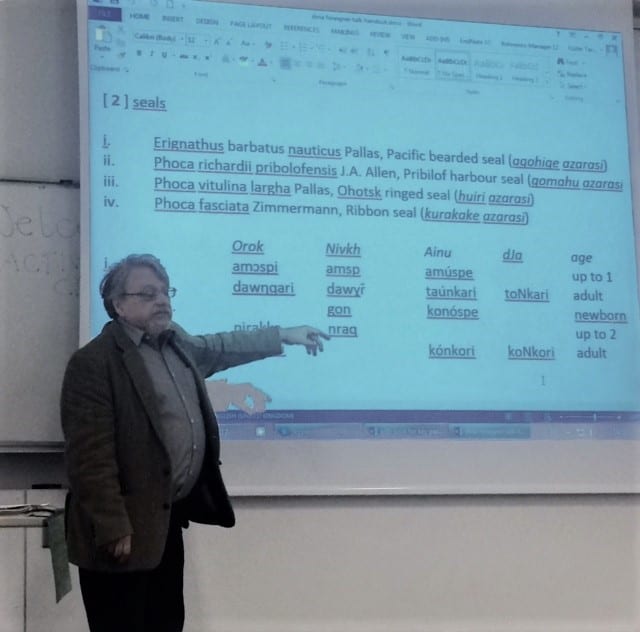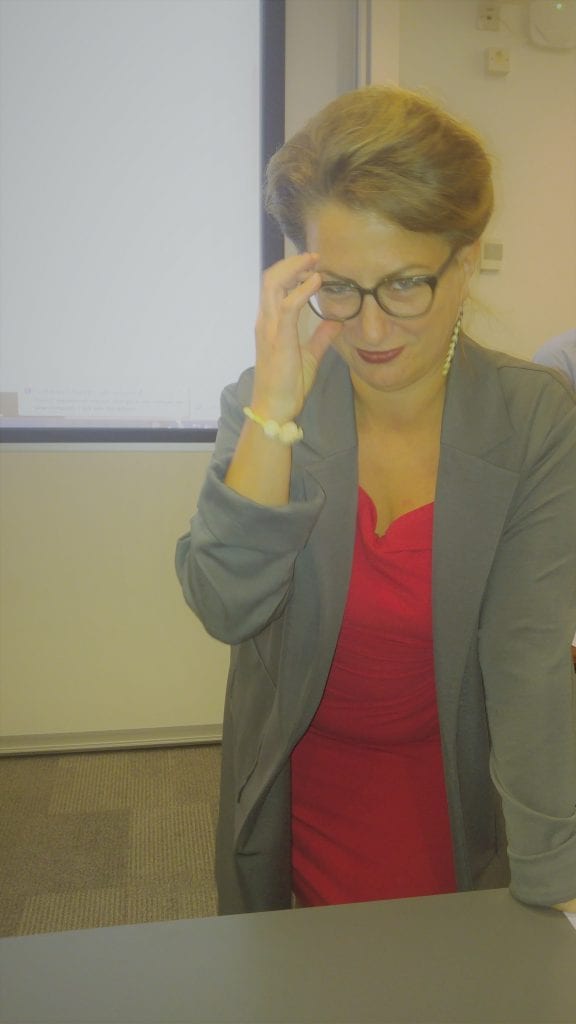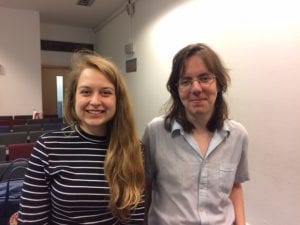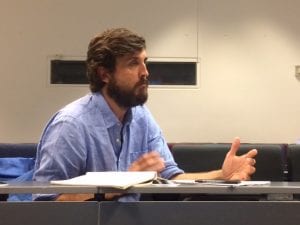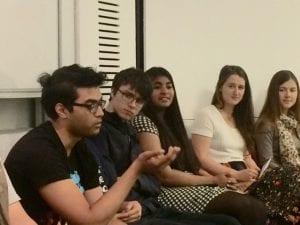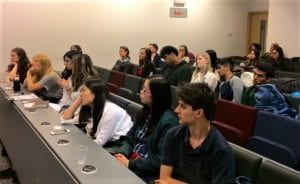Foreigner talk : A seminar on language acquisition, variation, and change in a migrant context and the linguistic representations of Others
By Lisa Walters, on 26 June 2017
Eszter Tarsoly, Senior Teaching Fellow in Hungarian Language
In his 1975 paper entitled Toward a Characterization of English Foreigner Talk, Charles Ferguson mentions three types of modified speech used in communities with speakers whose command of language is seen as lacking or inferior compared to an adult native speaker’s competence. The three types of modified speech are: ways of talking to deaf people, baby talk, and foreigner talk. Ferguson argued that by studying these modified ways of speaking we gain insights into such notions as “simple”, “basic”, and “deep”, which characterise general discourses of language. In addition, the study of baby talk has proven to be of value for understanding child-language development and the study of foreigner talk may contribute to analysing the process of pidginization, the development of new language varieties, and language change.
Ferguson (1975, 2) defined foreigner talk as follows: “[f]oreigner talk is commonly regarded in a given speech community as an imitation of the way foreigners speak the language under certain conditions, and it is usually elicited more readily by asking for this kind of imitation than by asking the informant how he would speak to a foreigner”. A noteworthy point in this definition is the bidirectionality of imitation and copying: in order to speak so as to be understood by foreigners, native speakers modify their speech in a way that imitates the way the foreigner is perceived to speak. In other words, “modified input is modelled on perceived output” (Daniel Abondolo, lecture notes for the seminar).
With support from the UCL Institute of Advanced Studies, the UCL Festival of Culture, and the Global Citizenship Programme, on 6 June 2017 a one-day seminar was organised by linguists at SSEES with the participation of lecturers from several UCL departments (Department of Anthropology, Greek and Latin, Institute of Education) and from the Universitat Jaume I de Castelló, Spain. This one-day seminar explored multilingual linguistic practices and linguistic representations from two main angles. First, contributions based on an oral data-driven approach focused on language contact, language change, and language acquisition in migrant contexts in contemporary Europe and North America. Second, papers adopting a linguistic-representational angle looked at ways in which the speech of those seen as Others is explored for literary, dramatic, and poetic effect, as well as in religious practice and public discourse. What brought this wide range of themes together was the interface between linguistic variation and speakers’ attitudes to variation, on the one hand, and, on the other, between beliefs about language and linguistic output. Attitudes towards, and perceptions of, language may prompt modified linguistic output, thus, linguistic practices are inevitably enmeshed with political and social structures, as well as systems of faith. Contributors looked at these themes through presenting linguistic research from a variety of disciplinary approaches, including language acquisition in multilingual settings, the use of Greek dialects in Old Comedy, quotation in Araweté and Nivkh, and emerging contact varieties of Romanian and Hungarian. The following is a brief report on individual papers and the discussions that they generated.
Eszter Tarsoly, who facilitated the events of the day, introduced the seminar by providing four short case studies of speech perceived as the language of Others in Hungarian, English, and Boyash, a Romanian dialect spoken by a group seen as Gypsy in Hungary. The first case study focused on possible reactions to normative language varieties in prose fiction, the theory of verse, and on the context of heritage-language learning in a classroom setting. While speakers of low-prestige language varieties may choose to adapt their ways of speaking (and writing) to accommodate the features of the prestige variety, they might also deliberately divert from, and subvert, the norm. This dynamic is particularly intriguing when it brings about the development of new literary varieties and genres. The second and third case studies looked at perceptions of pronunciation and speech, specifically the ways in which “East European accent” and “Gypsy talk” feature in public discourse in English and Hungarian, respectively. The fourth case study showed an example of potential systematic differences between humans’ and God’s speech as well as quotatives in Boyash folk tales; an area which is one of Eszter’s current interests.
The second speaker, Froso Argyri, of the UCL Institute of Education and co-founder of UCL BiLingo, a UCL-based multilingualism/bilingualism advisory service, contributed a paper on bilingual language development in childhood with an emphasis on heritage-language abilities and development. Heritage languages are languages and language varieties which are learnt at home and/or in a community-school setting, and which are different from the language of the majority (e.g. Polish or Bengali in the UK when learnt in Polish- or Bengali-speaking migrant families). Heritage speakers’ production of the heritage language, however, is also different from non-bilingual speakers’ production of the same language partly because of reduced input in the heritage language and pressures from the host language. Greek provides a particularly interesting case study, as approximately five million people use it as a heritage language (the total number of speakers is approximately 13.5 million). A recent study on post- vs. pre-verbal subject-placement in Greek as a heritage language in an English-language majority context has shown that the amount of home-language input plays a crucial role in heritage language development. In the second part of the talk, heritage-language acquisition was discussed from multiple perspectives, including the benefits of an additive approach to the simultaneous learning of both the majority and the migrant language, the cognitive advantages of bilingualism, such as better focus on tasks, slower cognitive ageing, delayed onset of dementia, etc., as well as the impact of migrant-language use on human wellbeing. Froso’s talk concluded with a short discussion of what UCL BiLingo offers to the community.
The third paper, given by Kim Schulte, of the Universitat Jaume I de Castelló, Spain, examined the linguistic situation of the large Romanian migrant community (180,000, approximately 15%, in 2012) that has established itself in Castellón, on the Spanish east coast, over the past two decades, adding Romanian as a migrant language to the traditional diglossic situation between Spanish and Valencian. A visual illustration of the linguistic landscape in Castellón provided a background to the sociolinguistic context by showing examples of mixed-language signs and other instances of linguistic diversity in this urban setting. A discussion of language attitudes revealed that, although there is wide-spread awareness of the similarity between Spanish, Valencian, and Romanian, the latter is of relatively low prestige with receding usage domains. In addition, even first-generation migrants feel comfortable speaking the host language, which is due, in part, to the similarities stemming from the historical relatedness of the languages, and in part to a modern-day contact through Latin American television series broadcast in Romania. By looking at linguistic features that have emerged or changed due to language contact (e.g. established borrowed phrases in Romanian, features of morphological integration, an increasing preference for a prepositional possessive), the speaker argued that borrowing is usually motivated by (the often conflicting) goals of linguistic precision and economy. The new language variety, Rumañol, which has thus emerged, is used even by those who speak both Spanish and Romanian fluently; its use is, in fact, more prominent among second generation migrants. Hence, it is possible that Rumañol is neither a temporary language variety spoken by migrants, nor a stylised variety used to imitate, and poke fun at, the mixing of languages, but rather an emerging Romance contact variety, whose main social function is that of an insider language: speaking Rumañol is an additional skill which allows speakers to exhibit bi-lingual and bi-cultural identity.
The last contribution in the first panel was a paper delivered by Petra Urszuly and Dávid György, students of Anthropology and Romance linguistics, respectively, at UCL, who summarised the findings of a research-based learning task which addressed features of, and attitudes towards, “Campus Hungarian” (CH): a temporary variety of Hungarian spoken by Hungarian students at UK university campuses (supervised by Eszter Tarsoly). Based on linguistic field notes, observation, and data taken from various social media outlets between January and March 2017, the differences between CH and contemporary standard Hungarian were discussed (e.g. inflectional and derivational domestication of borrowed noun and verb stems, integration of loans through vowel harmony, context-specific and cultural motivations for borrowing) with special focus on the features of borrowing, adaptation, and morphological integration of English loans in both CH and standard Hungarian. Among the reasons for code switching and language crossing in a campus environment, cultural specificity and precision, brevity of expression, mismatches between semantic fields and cultural realia are particularly important. A language-attitude questionnaire, completed by 120 UK-based Hungarian-native-speaking students v. 40 students based in Hungarian universities, surveyed speakers’ attitudes towards CH, and found that CH is clearly distinguishable from Hungarian student slang, but it is not consciously used by speakers for the expression of group identity. Instead, users’ attitudes towards it are rather negative, with qualitative data showing purist postures on the part of students, but also instances of stylization and identification with this variety. In the concluding discussion it was suggested that further research would be necessary to compare CH with other contemporary contact varieties of Hungarian in an English-majority setting.
The first speaker on the second panel, Stephen Colvin, of the UCL Department of Greek and Latin, surveyed the evolution of ancient Greek attitudes to linguistic variation by discussing literary representations of dialects and foreigner talk. The paper traced the origin of certain value-laden assumptions about language, which are still prevalent in European linguistic thought, to the rise of prose in the post-Classical period. In the Classical period, it was possible to speak of Greece and Greek without either of them being codified in grammars and dictionaries or symbolically united by law. Of the large dialectal areas, the Attic, Doric, Ionic, and Aeolic dialects were associated with various literary genres (e.g. Doric-speaking Spartans listened to martial hymns in Ionic). In the epic genre and tragedy there are no traces of foreigner talk. Outsiders’ speech in Old Comedy, however, is caricatured both by foreign-sounding, and superficially observed, exclamations, oaths, and interjections, as well as by elaborate systems of foreigner talk, as in the Scythian’s speech in Aristophanes’ Lysistrata (e.g. confusion of long and short vowels, inability to pronounce aspirated consonants, dropping of final –n, etc.). Interestingly, many of the language features caricatured as belonging to the speech of low-prestige outsiders (slaves,foreigners, and women) were later to become standard features of Greek. The notion of correctness – and the spatial-metaphorical conceptualisation of “high” v. “low” – came to be applied to language only in the post-classical period. Linguistic variation became a source of preoccupation for writers who increasingly embraced the idea that their use of language could be modified to accommodate the features of Classical prose (the language of Plato and Aristotle) and the Attic dialect in which the genre was originally written. Prose thus came to be seen as the “high” genre and the “real” language variety, associated with rationality and manliness. This value-oriented posture was gradually transmitted to the dialect associated with the genre.
The next paper, by Guilherme Heurich of the UCL Department of Anthropology, explored reported speech in Amazonian Society, specifically in Araweté, a Tupi-Guarani language, spoken by fewer than five hundred people, most of whom also speak Portuguese. The Araweté came into contact with the Brazilian government as late as the 1970s; hence, they were monolingual until relatively recently (the mid-1980s). Based on a 14 months’ fieldwork among them, Guilherme observed that alterity has a central role in organising the Araweté’s world (e.g. family members are often described in similar terms as enemies) and alterity as an organising principle is reflected in their use of reported speech and evidentials. Thus, the daily use of reported speech among the Araweté is a way of making relations visible through citations, a daily practice that also retains Otherness as a quality. Since Araweté verbal art is tightly linked to Others and also draws heavily on reported speech (e.g. when humans/shamans catch and kill spirits with the help of the gods, they are able to voice them; only the deceased are able to quote divinities, which humans can hear only through the mouth of the shaman, etc.), citations in daily conversations are reminiscent of the relations with other-than-human beings such as enemies, animals, divinities and spirits. In a hierarchical network of power relations (e.g. gods can capture humans and spirits, spirits can capture humans, humans can capture enemies, animals, and also spirits, but the latter only with divine help) quoting becomes a form of violent action. Symbolic “capturing” serves as a precursor to quoting Others, thus rendering predation and capturing closely tied to reporting and capturing the Others’ words.
The last contribution was by Daniel Abondolo, of the UCL School of Slavonic and East European Studies, and it centred on a few key passages from a short narrative in South-Sakhalin Nivkh and its translation into Japanese by the same speaker. Nivkh – older name: Gilyak – is a language isolate spoken by a few hundred speakers, all of whom are now Russian-Nivkh or Japanese-Nivkh bilinguals, and among whom complex patterns of multilingualism have existed historically as well. The text we looked at explored deception (boasting, lying, irony) in communication between ethnicities (of humans), and among other species: fox and seals, human and fox, and various unidentified monsters. The short Nivkh narrative tells the story of a fox’s miraculous escape – through a natural bridge formed of seals’ heads – from a floating ice sheet, and the way the fox later misleads an unassuming human in order to stock up on fat for a nutritious meal. Unsurprisingly, there are three different terms in Nivkh which translate into English as ‘fox’: keq, herf, and plajrf, of which the first is ‘the disguised one, the one that wears the garment’. In the Nivkh text, we heard expletives (passages from the fox’s mournful song while floating on the ice sheet) based, perhaps, on a stem which means both ‘(it) hurts’ and ‘go down to sea’. When seals appear, however, the fox (here, keq ‘the one who wears the garment’) insists, deceitfully, that its crying is, in fact, an ancient song. From another passage, we learn that it is at times difficult to tell various Others, such as women and fox, apart, the only available give-away being the way they count. Fox tend to make mistakes in the names of certain numerals. The paper finished with an overview of the rich variety of words and expressions (eighteen in the text) referring to various kinds of monsters, of which milk is a type which is represented by the largest array of subordinate categories.
The seminar ended with participants considering possible follow-up activities, such as a roundtable discussion in the autumn and other forms of collaboration.
In the late afternoon, students on The Danube: A Voyage through the Heart of Europe Global Citizenship summer school held a panel discussion on their experience of learning eight languages of the Danube region and conducting ethnographic work among migrant communities in London. The concluding discussion centred on ways in which language learning, ethnography, and creative projects (portrait photography and documentary film-making) contribute to a development of empathy towards previously unknown Others. The students’ reflective blog entries and documentary films can be viewed on the Danube-on-Thames website. An exhibition entitled A Sense of Belonging: Mosaics from a New Portrait of London in the Waterstones Gallery on Malet Place showcases the portrait photographs taken by students alongside works by independent artists, addressing the theme of migration as an essential of human existence.
 Close
Close


